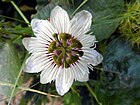Note: This is a project under development. The articles on this wiki are just being initiated and broadly incomplete. You can Help creating new pages.
Difference between revisions of "Passiflora foetida"
| Line 1: | Line 1: | ||
[[File:Passiflora caerulea NBG LR.jpg|thumb|right|'''Passiflora foetida''']] | [[File:Passiflora caerulea NBG LR.jpg|thumb|right|'''Passiflora foetida''']] | ||
| − | '''Passiflora foetida''' | + | '''Passiflora foetida''' is a species of passion flower out of 550 species of Passiflora. It is native to the southwestern United States, Mexico, the Caribbean, Central America, Africa ,and much of South America. |
==Uses== | ==Uses== | ||
{{Uses|Emmenagogue}}, {{Uses|Headache}}. | {{Uses|Emmenagogue}}, {{Uses|Headache}}. | ||
| Line 8: | Line 8: | ||
==Chemical Composition== | ==Chemical Composition== | ||
| − | Phytochemicals such as carbohydrates, protein, fat, reducing sugar, ascorbic acid, flavonoids, alkaloid, phosphorous, magnesium, calcium, amino acid, cholesterol and phenolic compounds. | + | Phytochemicals such as carbohydrates, protein, fat, reducing sugar, ascorbic acid, flavonoids, alkaloid, phosphorous, magnesium, calcium, amino acid, cholesterol and phenolic compounds.<ref name="chemical composition"/> |
| − | <ref name="chemical composition"/> | ||
==Common names== | ==Common names== | ||
| − | {{Common names|kn=Kukkiballi|ml=Chirranchantiya, Poochapalam|sa=|ta=Siruppunaikkali, Chiru punai-k-kali | + | {{Common names|kn=Kukkiballi|ml=Chirranchantiya, Poochapalam|sa=|ta=Siruppunaikkali, Chiru punai-k-kali|te= Tellajumiki|hi=Jhumka lata|en=Love-in-a-mist, Stinking passionflower}} |
==Properties== | ==Properties== | ||
| Line 35: | Line 34: | ||
==Identification== | ==Identification== | ||
===Leaf=== | ===Leaf=== | ||
| − | {{Leaf|Simple| | + | {{Leaf|Simple|Leaves are three- to five-lobed and viscid-hairy|When crushed, these leaves give off a pungent odor that some people consider unpleasant}}<ref name="Leaf"/> |
===Flower=== | ===Flower=== | ||
| − | {{Flower|Bisexual| | + | {{Flower|Bisexual|Broadly ovate|White to pale cream||About 5–6 cm diameter}} |
===Fruit=== | ===Fruit=== | ||
| − | {{Fruit|Simple Fruit| | + | {{Fruit|Simple Fruit|Ovoid|2–3 cm diameter|Yellowish-orange to red|}} |
===Other features=== | ===Other features=== | ||
| Line 52: | Line 51: | ||
==How to plant/cultivate== | ==How to plant/cultivate== | ||
| − | Succeeds in warm temperate to tropical areas. Plants require a temperature no lower than around 16°c when they are flowering in order to ensure fruit set. | + | Succeeds in warm temperate to tropical areas. Plants require a temperature no lower than around 16°c when they are flowering in order to ensure fruit set.<ref name="How to plant/cultivate"/> |
| − | <ref name="How to plant/cultivate"/> | ||
==Commonly seen growing in areas== | ==Commonly seen growing in areas== | ||
| Line 77: | Line 75: | ||
==External Links== | ==External Links== | ||
| − | * [https://npgsweb.ars-grin.gov/gringlobal/taxonomydetail.aspx?id=26968 Passiflora foetida] | + | * [https://npgsweb.ars-grin.gov/gringlobal/taxonomydetail.aspx?id=26968 Passiflora foetida on grin global] |
[[Category:Herbs]] | [[Category:Herbs]] | ||
[[Category:Passifloraceae]] | [[Category:Passifloraceae]] | ||
Revision as of 11:19, 29 June 2020
Passiflora foetida is a species of passion flower out of 550 species of Passiflora. It is native to the southwestern United States, Mexico, the Caribbean, Central America, Africa ,and much of South America.
Contents
[hide]- 1 Uses
- 2 Parts Used
- 3 Chemical Composition
- 4 Common names
- 5 Properties
- 6 Habit
- 7 Identification
- 8 List of Ayurvedic medicine in which the herb is used
- 9 Where to get the saplings
- 10 Mode of Propagation
- 11 How to plant/cultivate
- 12 Commonly seen growing in areas
- 13 Photo Gallery
- 14 References
- 15 External Links
Uses
Parts Used
Chemical Composition
Phytochemicals such as carbohydrates, protein, fat, reducing sugar, ascorbic acid, flavonoids, alkaloid, phosphorous, magnesium, calcium, amino acid, cholesterol and phenolic compounds.[1]
Common names
| Language | Common name |
|---|---|
| Kannada | Kukkiballi |
| Hindi | Jhumka lata |
| Malayalam | Chirranchantiya, Poochapalam |
| Tamil | Siruppunaikkali, Chiru punai-k-kali |
| Telugu | Tellajumiki |
| Marathi | NA |
| Gujarathi | NA |
| Punjabi | NA |
| Kashmiri | NA |
| Sanskrit | |
| English | Love-in-a-mist, Stinking passionflower |
Properties
Reference: Dravya - Substance, Rasa - Taste, Guna - Qualities, Veerya - Potency, Vipaka - Post-digesion effect, Karma - Pharmacological activity, Prabhava - Therepeutics.
Dravya
Rasa
Guna
Veerya
Vipaka
Karma
Prabhava
Habit
Identification
Leaf
| Kind | Shape | Feature |
|---|---|---|
| Simple | Leaves are three- to five-lobed and viscid-hairy | When crushed, these leaves give off a pungent odor that some people consider unpleasant |
Flower
| Type | Size | Color and composition | Stamen | More information |
|---|---|---|---|---|
| Bisexual | Broadly ovate | White to pale cream | About 5–6 cm diameter |
Fruit
| Type | Size | Mass | Appearance | Seeds | More information |
|---|---|---|---|---|---|
| Simple Fruit | Ovoid | 2–3 cm diameter | Yellowish-orange to red | {{{6}}} |
Other features
List of Ayurvedic medicine in which the herb is used
Where to get the saplings
Mode of Propagation
How to plant/cultivate
Succeeds in warm temperate to tropical areas. Plants require a temperature no lower than around 16°c when they are flowering in order to ensure fruit set.[3]
Commonly seen growing in areas
Photo Gallery
References
External Links
- Ayurvedic Herbs known to be helpful to treat Emmenagogue
- Ayurvedic Herbs known to be helpful to treat Headache
- Herbs with Fruits used in medicine
- Herbs with Leaves used in medicine
- Herbs with common name in Kannada
- Herbs with common name in Hindi
- Herbs with common name in Malayalam
- Herbs with common name in Tamil
- Herbs with common name in Telugu
- Herbs with common name in English
- Habit - Herbs
- Index of Plants which can be propagated by Seeds
- Herbs that are commonly seen in the region of Lowland forest
- Herbs
- Passifloraceae




